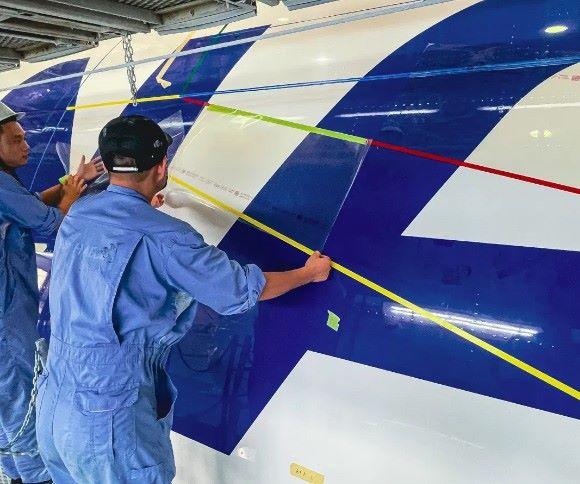
FLORENCE, Italy—Lufthansa Technik confirms it is developing a drag-reducing riblet film retrofit plan for the Airbus A330 amid growing interest in its AeroShark surface film technology co-developed with European chemical conglomerate BASF.
The maintenance, repair and overhaul (MRO) company has already developed the modification under a supplemental type certificate (STC) for the Boeing 777, the application on which typically involves covering up to 950 m2 (10,200 ft.2) with the film, which incorporates small ridge-like ribs, or riblets, measuring approximately 50 micrometers (0.002 in.) high.
Now in service on almost 20 aircraft, Lufthansa Technik meanwhile continues to see more orders for 777 retrofits than it can handle, says Jens-Uwe Müller, product sales lead for AeroShark. Speaking at the 2024 Congress of the International Council of the Aeronautical Sciences, he adds that “we can’t fulfill demand with our own capabilities and so are training others to do it.”
Müller’s comments come as All Nippon Airways (ANA) becomes the latest carrier to begin equipping its 777 fleet with riblets, and the first to modify both passenger and freighter versions. The first of two retrofitted 777s, a freighter variant, began scheduled cargo flights earlier in September. ANA says it “will validate the effectiveness of this technology in ANA’s daily operation, with plans to expand its use across other aircraft of the same type.”
ANA’s use of the technology follows the recent news that Taipei-based EVA Air is modifying its nine 777Fs with the riblet film. In that case the modification was performed by EVA Air’s affiliate, Evergreen Aviation Technologies Corporation. EVA Air’s entire 777F cargo fleet is expected to be equipped until 2027.
Other operators that have announced plans to modify their aircraft with the AeroShark treatment include Austrian Airlines which is equipping four 777-200ERs, and the Lufthansa Group, which is flying the film on a 747-400, 12 Swiss 777-300ERs and five Lufthansa Cargo 777Fs.
The surface treatment reduces fuel burn by around 1%, Müller says. In the case of ANA, this is expected to result in annual savings of approximately 250 metric tons of fuel and 800 metric tons of CO2 for each aircraft. The current 777 STC involves coverage of around 40% of the wetted area, and around 80% of the surface of the fuselage. Müller says the fuel burn reduction could potentially be extended to up to 3% if the coverage area includes the crown of the fuselage as well as the wings.
Originally expected to have a service lifetime of around four years, the riblets have also proved to be more durable since they first entered service in 2019. “It looks like it can operate for a full aircraft paint cycle,” he says, adding that the film is removed by polishing it off.





